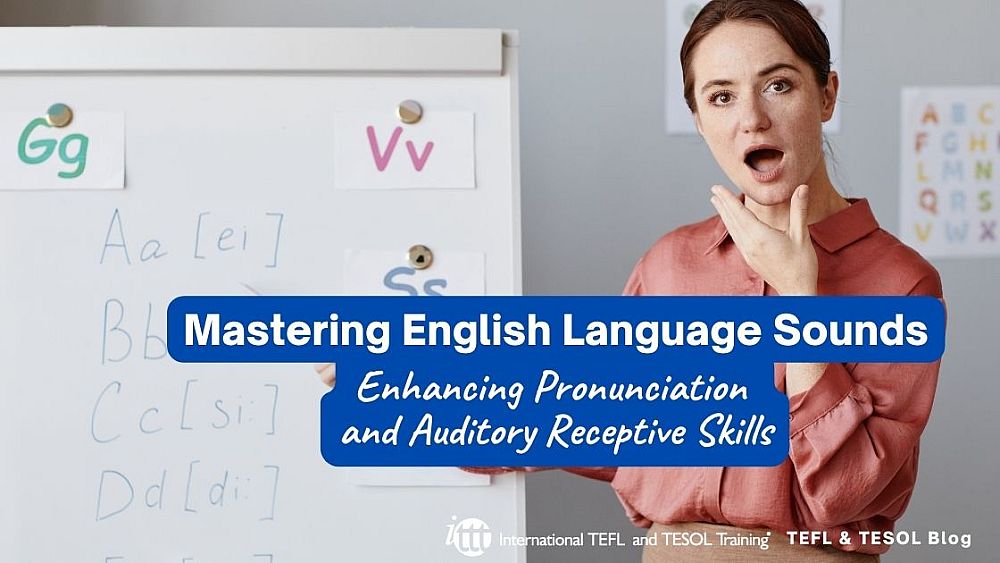Mastering English Language Sounds: Enhancing Pronunciation and Auditory Receptive Skills

Explore the challenges and strategies in teaching English language sounds and pronunciation across different age groups.It's widely known that students of various age groups exhibit varying learning capacities. Despite these differences and regardless of background or origin, learners of English (referred to as L2) often struggle with speaking and listening due to the language's heavy reliance on auditory comprehension. This article delves into the importance of addressing these pronunciation challenges, especially in the context of teaching English as a second language.
Table of Contents
Understanding Age-Related Differences
Young Learners: Nurturing the Phonetic Foundation
Navigating the Teenage Years: 12-18 Age Group
Engaging Adult Learners: The Journey Beyond
Conclusion: Empowering Effective Pronunciation Education
Are you ready to teach English as a foreign language?
Check out what our course grads say in our many video testimonials!
Disclaimer: The views and opinions expressed in this blog post are solely those of the author, an alumni of ITTT (International TEFL and TESOL Training). They do not necessarily reflect the views or opinions of ITTT. The content provided in this post is for informational purposes only and should not be considered as official endorsement or representation by ITTT.
Understanding Age-Related Differences
Age significantly shapes students' abilities, attention spans, and phonetic learning capacities. To effectively teach English language sounds, it's essential to tailor approaches based on age. Whether learners are under 12, between 12 and 18, or adults, grasping their unique traits is crucial for successful instruction.
Young Learners: Nurturing the Phonetic Foundation
Children up to 12 years old, often referred to as young learners (YLs), exhibit remarkable sound differentiation capabilities and language learning potential. However, YLs face challenges such as limited attention spans and sensitivity. For this age group, phonetic education should be engaging, incorporating playful activities like games, songs, and interactive exercises.
Navigating the Teenage Years: 12-18 Age Group
Teenagers aged 12 to 18 possess slightly diminished language learning abilities compared to YLs. They excel in grammar comprehension and focusing on tasks. Often under peer and parental pressures, these learners may have specific language goals. Addressing their pronunciation issues involves emphasizing separate word pronunciation, using tongue twisters, and fostering a supportive group environment to reduce self-consciousness.
Engaging Adult Learners: The Journey Beyond
Adult learners exhibit more rigid language processing patterns due to the Broca's area. Overcoming these patterns requires activities involving audio, visuals, and rigorous drilling. Adults' higher attention spans and clear language learning objectives make them ideal candidates for intensive pronunciation training through the International Phonetic Alphabet (IPA) and structured mouth organs' descriptions.
Conclusion: Empowering Effective Pronunciation Education
Teaching English language sounds and pronunciation is a dynamic endeavor that demands tailored strategies for various age groups. Recognizing age-related differences, designing engaging activities, and integrating innovative tools like the IPA are pivotal to helping learners overcome pronunciation challenges and attain proficiency in spoken English.
Are you ready to teach English as a foreign language?
Apply now & get certified to teach english abroad!
Speak with an ITTT advisor today to put together your personal plan for teaching English abroad!
Send us an email or call us toll-free at 1-800-490-0531 to speak with an ITTT advisor today.
Related Articles:
- Top 10 Cities in Europe with the Highest Demand for English Language Teachers
- 5 Reasons To Take A TEFL Course Right Now - Even If You Are Not Leaving Yet | ITTT | TEFL Blog
- All the Documents You Will Need to Teach English Abroad
- The Impact of Positive Motivation on an ESL Classroom
- You're Never Too Old to Change Your Life and Do a TEFL Course | ITTT | TEFL Blog
- Getting Student Placement Right - The Best Desk Arrangements for EFL Students
Check out what our course grads say in our many video testimonials!
[0] Murray J. Munro, "Pronunciation learning and teaching: What can phonetics research tell us?", par. 3.2, https://www.isca-speech.org/archive_v0/ISAPh_2016/pdfs/5.pdf[1] Eleonore Smalle, Mike P. A. Page, Wouter Duyck, Martin Edwards, Arnaud Szmalec, "Children retain implicitly learned phonological sequences better than adults : a longitudinal study", https://biblio.ugent.be/publication/8533270[2] Michael Rotte, "Age-related differences in the areas of Broca and Wernicke using functional magnetic resonance imaging", https://academic.oup.com/ageing/article/34/6/609/40348



